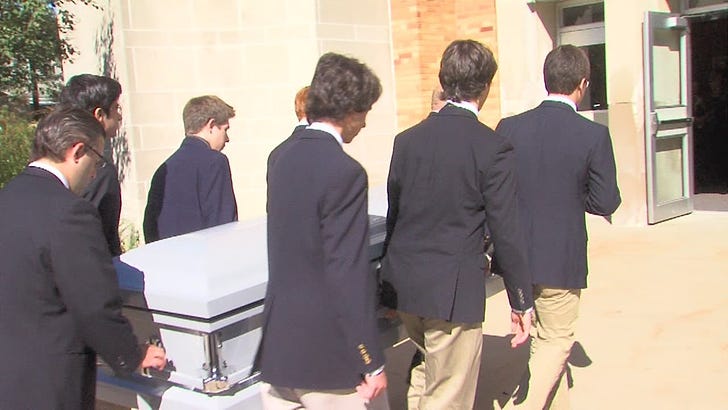“Today we were honored to serve the funeral of Maria. Maria had no family or friends in attendance.”
So begins a Facebook post on the page of the Arimathea Pallbearer Ministry at St. Ignatius High School in Cleveland, Ohio. Accompanying those words is a photo of six young men standing near a casket, their heads bowed as another man offers a graveside prayer.
Those seven people are the only humans in the photo, aside from the deceased inside her casket, whom none of them knew.
I first learned about this group many years ago from a student who participated in it. They serve as pallbearers for people who don’t have anyone else to do it. According to the group’s website, it specifically exists to serve “the poor and indigent by carrying deceased men and women who have little or no family to their final place of rest.”
They do this for about 250 funerals every year. Here’s a news story about them.
It’s a beautiful thing, and it’s one of those things that strikes me clearly—and many others, I presume—as the right thing to do.
We should honor the dead, even those whom we never knew. We should engage in such a ritual to recognize the dignity of every life, regardless of the worldly status that person had or the circumstances of his or her life.
But why?
Setting aside matters of religion—burying the dead is one of the seven Catholic corporal works of mercy—and any spiritual notions about the sanctity of human life, what is it about the work of this group that makes it seem like a noble endeavor? Why is it worthwhile for those who do it?
One could argue that doing something for others in a time of need or distress helps our society function better than it would if no one stepped up to help them. That certainly seems to be true.
Another argument could be that helping other people can make you feel good. That’s also true, and I’m sure that the young men who do this work reap emotional rewards in the form of some sort of satisfaction or connection with something that matters.
It’s plausible that doing this type of work has social rewards. Being seen by others as someone who does good deeds—a helper—might boost one’s status in a way. It probably doesn’t hurt on a college application either.
But these arguments get a bit more complicated when we consider doing good for those who are quite literally dead, especially when those situations are relatively private like in the case of Maria. No one else was present, so they’re not helping a grieving family. They don’t know the person, so they don’t have a direct connection to them.
And yet in those cases—the carrying of caskets like Maria’s—it seems to me even more like the right thing to do. But why? Is there something deeper going on?
Death, a Solitary Path
My nascent thesis is that one reason why it feels so right for someone to be carrying the homeless dead and attending to the burials of the indigent is that doing so helps us make sense of our own eventual death.
Dying, after all, is one of the more consequential things we do in life. It’s certainly the final thing we do, and in a sense, it’s one of the most solitary things we do. For most of us, we will be the only person we know who is dying at the same precise moment.
So when we participate in rituals that add at least some semblance of community to that ever-so-solitary final act of burial, it satisfies to some degree our own desire to not be left alone. It makes us feel, perhaps, that we too might not be forgotten after we die, quelling somewhat our fear of the lonely darkness ahead.
It also says something about who we are, whom we aspire to be, and how our stories might end.
As Phyllis Palgi and Henry Abramovitch concluded their 1984 article, “Death: A cross-cultural review,” in the Annual Review of Anthropology:
Death remains a mystery, inevitable but unknowable, irreversible but not immutable. The study cross-culturally which must begin with the "death of the other" inevitably leads one back to death of one's self. The challenge for the student of death is to find his place between the anxieties of a lonely individualism and the consolations of merging with something larger.
One can find death rituals across a wide range of human cultures, and although they differ, they all have something to do with reconciling the death of another with how we see ourselves and the narrative of our existence.
Maybe that’s why what those high school boys are doing for Maria and people like her is so powerful. It’s a cultural statement, one that whispers to the world a refrain found throughout so much of human history: that we must face death head-on, with dignity and respect for the process even if the deceased is what the world might call a “nobody.” Maybe especially if the deceased is a “nobody.”
And in so doing, we can face our own mortality with a bit more clarity and courage. Although we know not the day nor the hour, we can walk boldly onward with the knowledge or at least the hope that when that moment comes, we too might be part of a ritual that respects us and our dignity.
May that moment be one in which we don’t feel alone, even if we are. May it be one in which we have not just consolation but illumination, a recognition that we too are part of a much grander narrative punctuated by love and loss, faith and hope, sorrow and joy.
References and for further reading
Dignity in Death: Catholic High Schoolers Bury the Dead (article in the National Catholic Register)
Palgi, Phyllis, and Henry Abramovitch. "Death: A cross-cultural perspective." Annual Review of Anthropology 13, no. 1 (1984): 385-417. Link



